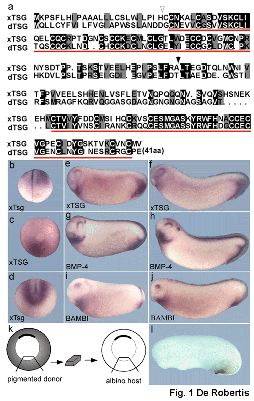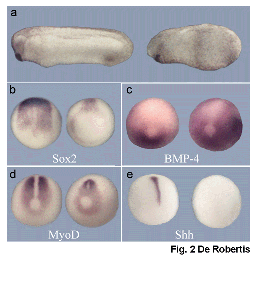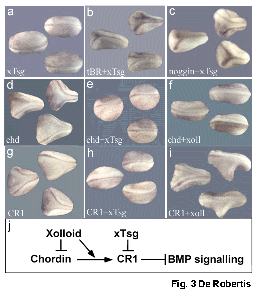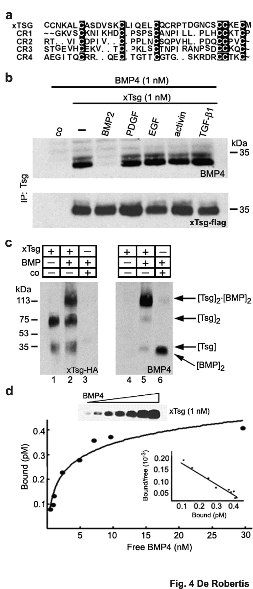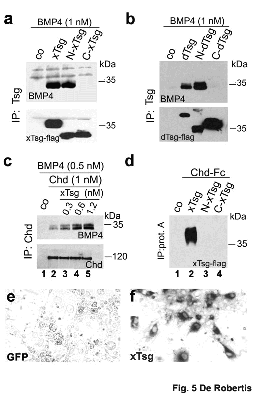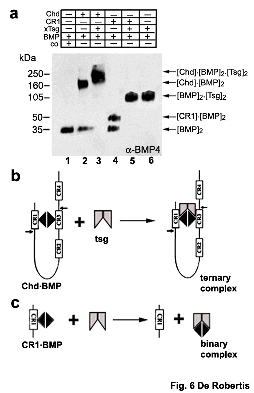The evolutionarily conserved BMP-binding protein Twisted Gastrulation promotes BMP signalling
Oelgeschläger, M., Larraín, J., Geissert,
D. and De Robertis, E.M.
Dorsal-ventral patterning in vertebrate and Drosophila embryos requires a conserved system of extracellular proteins to generate a gradient of positional information. The components involved include Bone Morphogenetic proteins (BMP/Dpp), a BMP antagonist (Chordin/Short gastrulation), and a secreted metalloproteinase (Xolloid/Tolloid) that cleaves Chd/Sog. Here we introduce an additional player, Xenopus Twisted gastrulation (xTsg), to this signalling pathway. xTsg is expressed ventrally as part of the BMP-4 synexpression group and encodes a secreted BMP-binding protein that is an agonist of BMP signalling. The data suggest a molecular mechanism by which xTsg dislodges latent BMPs bound to Chordin BMP-binding fragments generated by Xolloid cleavage, providing a permissive signal that allows high levels of BMP signalling in the embryo. Drosophila Tsg also binds BMPs and since it is expressed dorsally, the results support the proposal that an inversion of the dorsal-ventral axis took place in the course of animal evolution.
Click on the figures below to see them in bigger size
| Figure 1: xTsg shares two conserved regions with dTsg and is co-expressed with BMP-4 and BAMBI | Figure 2: Microinjection of xTsg mRNA leads to ventralisation of the embryo |
| Figure 3: xTsg blocks secondary axis formation by CR1 downstream of Chordin cleavage by Xolloid | Figure 4: xTsg binds to BMP specifically and directly |
| Figure 5: The Twisted Gastrulation N-terminal domain is sufficient to interact with BMP-4, but not with Chordin. | Figure 6: xTsg competes the binding of BMP-4 to CR1 but not to full-length Chordin |
Proteolytic cleavage of Chordin as a switch for the dual activities of Twisted gastrulation in BMP signaling
Juan Larrain, Michael Oelgeschläger, Nan I. Ketpura, Bruno Reversade, Lise Zakin, L. and E. M. De Robertis
Development 128, 4439-4447 (2001)
Dorsoventral patterning is regulated by a system of interacting secreted proteins involving BMP, Chordin, Xolloid and Twisted gastrulation (Tsg). We have analyzed the molecular mechanism by which Tsg regulates BMP signaling. Overexpression of Tsg mRNA in Xenopus embryos has ventralizing effects similar to Xolloid, a metalloprotease that cleaves Chordin. In embryos dorsalized by LiCl treatment, microinjection of Xolloid or Tsg mRNA restores the formation of trunk-tail structures, indicating an increase in BMP signaling. Microinjection of Tsg mRNA leads to the degradation of endogenous Chordin fragments generated by Xolloid. The ventralizing activities of Tsg require an endogenous Xolloid-like activity, as they can be blocked by a dominant-negative Xolloid mutant. A BMP-receptor binding assay revealed that Tsg has two distinct and sequential activities on BMP signaling. First, Tsg makes Chordin a better BMP antagonist by forming a ternary complex that prevents binding of BMP to its cognate receptor. Second, after cleavage of Chordin by Xolloid, Tsg competes the residual anti-BMP activity of Chordin fragments and facilitates their degradation. This molecular pathway, in which Xolloid switches the activity of Tsg from a BMP antagonist to a pro-BMP signal once all endogenous full-length Chordin is degraded, may help explain how sharp borders between embryonic territories are generated.
The pro-BMP activity of Twisted gastrulation is independent of BMP binding
Michael Oelgeschläger, Bruno Reversade, Juan Larrain, S. Little,
Mary C. Mullins and E. M. De Robertis
Development 130, 4047-4056 (2003)
The determination of the vertebrate dorsoventral body axis is regulated in the extracellular space by a system of interacting secreted molecules consisting of BMP, Chordin, Tolloid and Twisted Gastrulation (Tsg). Tsg is a BMP-binding protein that forms ternary complexes with BMP and Chordin. We investigated the function of Tsg in embryonic patterning by generating point mutations in its two conserved cysteine-rich domains. Surprisingly, Tsg proteins with mutations in the N-terminal domain were unable to bind BMP, yet ventralized the embryo very effectively, indicating strong pro-BMP activity. This hyperventralizing Tsg activity required an intact C-terminal domain and could block the anti-BMP activity of isolated BMP-binding modules of Chordin (CRs) in embryonic assays. This activity was specific for CR-containing proteins as it did not affect the dorsalizing effects of Noggin or dominant-negative BMP receptor. The ventralizing effects of the xTsg mutants were stronger than the effect of Chordin loss-of-function in Xenopus or zebrafish. The results suggest that xTsg interacts with additional CR-containing proteins that regulate dorsoventral development in embryos.
Identification of a second Xenopus twisted gastrulation gene
Micahel Oelgeschläger, Uyen Tran, K. Grubisic and E.M. De
Robertis
Int. J. Dev. Biol. 48, 57-61 (2004)
Twisted Gastrulation (Tsg) is a secreted molecule which regulates BMP signalling in the extracellular space as part of an evolutionarily conserved network of interacting proteins. In Xenopus, maternal xTsg mRNA can be found throughout the early embryo. After gastrulation, xTsg is expressed as part of the BMP4 synexpression group until late tadpole stages. Here we report the identification of a second Xenopus Tsg gene (xTsg-2). Xenopus Tsg-2 is highly homologousto xTsg. In particular, amino acid residues which have been shown to be required for the binding of xTsg to BMP and to Chordin are conserved. The expression of Xenopus Tsg-2 mRNA was restricted to late stages of embryonic development; it was detected at tadpole stages in lateral plate mesoderm, neural crest, branchial arches and head mesenchyme. In microinjection experiments, the activity of xTsg-2 mRNA was similar to that of xTsg. We conclude that two Tsg genes act in distinct temporal and spatial territories in the course of Xenopus embryonic development.
Inactivation of mouse Twisted gastrulation reveals its role in promoting Bmp4 activity during forebrain development
Lise Zakin, L. and E. M. De Robertis
Development 131, 413-424 (2004)
Twisted gastrulation (Tsg) is a secreted protein that regulates Bmp signaling in the extracellular space through its direct interaction with Bmp/Dpp and Chordin (Chd)/Short gastrulation (Sog). The ternary complex of Tsg/Chd/Bmp is cleaved by the metalloprotease Tolloid (Tld)/Xolloid (Xld). Studies in Drosophila, Xenopus and zebrafish suggest that Tsg can act both as an anti-Bmp and as a pro-Bmp. We have analyzed Tsg loss-of-function in the mouse. Tsg homozygous mutants are viable but of smaller size and display mild vertebral abnormalities and osteoporosis. We provide evidence that Tsg interacts genetically with Bmp4. When only one copy of Bmp4 is present, a requirement of Tsg for embryonic development is revealed. Tsg-/-;Bmp4+/- compound mutants die at birth and display holoprosencephaly, first branchial arch and eye defects. The results show that Tsg functions to promote Bmp4 signaling during mouse head development.
Sirenomelia in Bmp7 and Twisted gastrulation compound mutant mice: requirement for Bmp signaling in the development of ventral mesoderm
Lise Zakin, Bruno Reversade, Hiroki Kuroda,Karen M. Lyons and E. M. De Robertis
Development 132, 2489-2499 (2005)
Sirenomelia or mermaid-like phenotype is one of the principal human congenital malformations that can be traced back to the stage of gastrulation. Sirenomelia is characterized by the fusion of the two hindlimbs into a single one. In the mouse, sirens have been observed in crosses between specific strains and as the consequence of mutations that increase retinoic acid levels. Here we report that the loss of Bone morphogenetic protein 7 (Bmp7) in combination with a half dose or complete loss of Twisted gastrulation (Tsg) causes sirenomelia in the mouse. Tsg is a Bmp- and Chordin-binding protein that has multiple effects in Bmp metabolism in the extracellular space; Bmp7 is one of many Bmps and is shown here to bind to Tsg. In Xenopus, co-injection of Tsg and Bmp7 morpholino (MO) oligonucleotides has a synergistic effect, greatly inhibiting formation of ventral mesoderm and ventral fin tissue. In the mouse, molecular marker studies indicate that the sirenomelia phenotype is associated with a defect in the formation of ventro-posterior mesoderm. These experiments demonstrate that dorsal-ventral patterning of the mouse posterior mesoderm is regulated by Bmp signaling as is the case in other vertebrates. Sirens result from a fusion of the hindlimb buds caused by a defect in the formation of ventral mesoderm.
